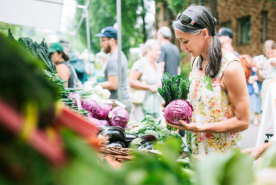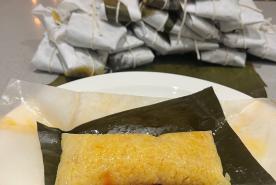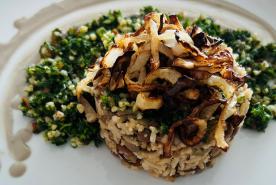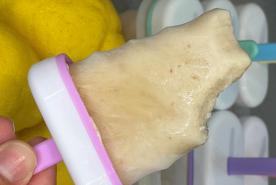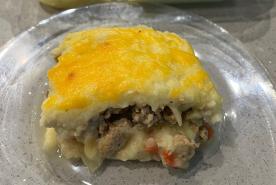March 15, 2024
By Mariselis Rosa-Sanchez, MD
Board Certified Pediatric Nephrologist and Plant-Based Chef
Have you noticed that food prices keep going up? Experts predict they might continue raising 1.3% by the end of 2024.1 Natural disasters, conflicts around the world, and events like COVID-19 are some reasons food is getting more expensive.
This has already made it more challenging to access nutritious foods. How do you maintain a healthy diet when faced with ever-increasing food costs?
It may be difficult, but not impossible! Here are five tips to help you cook on a budget while prioritizing kidney health:
1. Know your nutritional needs
Different people have different nutritional needs. Suppose you have or are at risk of kidney disease, high blood pressure, diabetes, or are on dialysis. Your needs will be different than those of someone without these conditions. Consult a healthcare provider or a kidney dietitian to understand what constitutes "good" nutrition for you.
You may need to watch:
- Sodium: 90% of Americans consume too much salt. Ask your healthcare provider how much you should have a day and stick to it.
- Potassium: Potassium is an important mineral that the body needs to survive. However, having too much or too little can be incredibly dangerous. If you have kidney disease, work with your healthcare provider to determine how much you need daily. If your levels are out of the normal range, they may prescribe medicine or test your blood more frequently.
- Protein: The type of amount you eat is essential for your overall well-being and can differ from person to person. For example, people on dialysis may need more protein than those with stage 3 or 4 kidney disease. The type of protein is also important. Meat-based proteins can be harder on the kidneys.
- Phosphorus: Phosphorus is a mineral that keeps your bones strong, but too much can have the opposite effect. Kidney disease can lead to excess in the body, harming bones and blood vessels over time. On the other hand, low phosphorus levels can also happen with kidney disease. This is very dangerous, especially for the muscles that help you breathe. Keep track of your phosphorus and ask your healthcare provider how to maintain healthy levels.
- Carbohydrates: You may need to monitor carbohydrates or sugar if you have or are at risk of diabetes. A registered dietitian nutritionist or diabetes educator can help create a diet plan that keeps your blood sugar levels steady throughout the day and night.
Learn more about kidney disease diets.
2. Plan ahead
One of the best ways to save money while eating healthy is to plan your meals ahead of time. Sit down and make a menu for the week, then create a shopping list based on what you need. Planning helps you avoid overbuying and wasting food. It also gives you time to search for the best prices and find coupons.
How to shop for meal planning:
- Shop at warehouse stores for great deals on bulk items like nuts, seeds, legumes, cereals, and grains.
- Choose store brands over name-brand items.
- Focus on whole foods rather than trendy labels like "organic" or "vegan" to get the most bang for your buck.
- Avoid buying pre-cut vegetables. They tend to be more expensive than whole ones.
- Check out farmers' markets in your area for more affordable and fresher produce options.
- Learn how to read food labels and pay attention to them when shopping.
- Choose highly processed foods carefully. They may be easier to cook but often lack nutritional value. They can even be more expensive in the long run.
Get more kidney disease meal-prepping tips.
3. Prepare Meals at Home
When you cook at home, you have control over the ingredients you use, which can be healthier and cheaper than dining out.
Restaurants often charge much more for dishes than the actual cost of ingredients. You also don't know what additives or how much salt they might be adding to your food.
Try the National Kidney Foundation's kidney disease-friendly recipes.
4. Swap animal proteins for plant-based alternatives
Plant-based proteins like tofu, legumes, tempeh, nuts, and seeds are cheaper than meat and better for your kidneys. Add more plant-based options to your diet to save money and improve your health.
Learn more about plant-based foods for kidney health.
5. Reduce Food Waste
Minimizing food waste is not only good for your wallet but also for the environment.
How to make the most out of your groceries:
- Use the "First In, First Out" rule to ensure you use older products before they spoil.
- Look for "ugly" fruits and vegetables. They're often on sale and just as nutritious. Use them to make stocks, sauces, soups, or preserves.
- Cut produce carefully to minimize waste.
- Get creative with leftovers by turning them into new dishes like stir-fries or salads.
- Plant you produce scraps and seeds. Once they are grown, you'll have fresh produce to pick from in your very own home.
- Proper storage can extend food life. Use air-tight containers and try freezing, pickling, or canning foods at home.
Are you looking for more guidance on a kidney-friendly diet? Find a dietitian in your area.
Source
1 “Summary Findings Food Price Outlook, 2024.” USDA ERS - Summary Findings, 25 Jan. 2024, www.ers.usda.gov/data-products/food-price-outlook/summary-findings/.



